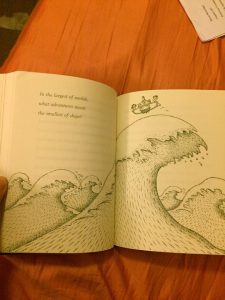Title: The Dreamer
Author: Pam Munoz Ryan
Illustrator: Peter Sis
Publisher/Year: Scholastic Press, 2010
Number of Pages: 355
Tags/Themes: Adventure, Award Book, Chapter Book, Emotion, Culture, Diversity, Family, Poetry, Historical Fiction, 4-5, Rebecca Cauthorn
Genre: Historical Fiction
Descriptive Annotation: This book was based on the famous poet Pablo Neruda’s life, except we don’t know this until the end. This emotional story is for anyone who is an outcast, who feels different than other people, or feels like they are letting their family down. We meet a young boy, Neftali, who is a dreamer. He loves to write, daydream, and imagine. His father thinks he is an absent-minded fanatic, who will amount to nothing. The story begins when Neftali is eight, and ends when he goes off to college. We watch him struggling to find a balance between being himself while pleasing his father, and root for him as he discovers his passion and gift for writing. Illustrations are included at the beginning of the chapter and sporadically throughout the book, accompanied with poetry that Pablo Neruda wrote later in his life (of course, we do not know yet that it is our beloved Neftali’s poetry we are reading). This book also comments on the issues of displacing native peoples for development, and uses little Spanish phrases throughout. This book would be excellent for someone who had a Chilean background, or anyone who felt like their differences were a bad thing. It is easy reading, but very long, so would be most appropriate for a 4th or 5th grade classroom.
Classroom Application: This book would be a great asset to help students recognize that we are all important and smart even if we are good at different things. Neftali wasn’t very good at math, but a very creative writer and thinker. It would also be good to assist a lesson on Native Americans to demonstrate that this displacement is still going on and to raise the question of right versus wrong. Another way to incorporate this book into the curriculum would be to have an entire mini unit devoted to it—for math, we could use leaves and twigs to illustrate multiplication by grouping, for social studies, we could investigate the displacement of Native Americans and native people all over, and for reading/writing we could write poetry that Neftali would have written, and then teach a lesson on Pablo Neruda and his poetry. We could also include art into this lesson by cutting out construction paper into a leaf or a beetle or a swan and write a poem on it and hang them in the classroom.
Linguistic and Cultural Diversity Analysis: This book does an exceptional job of raising awareness of and cultivating discussions about cultural diversity. Within the book, many different viewpoints are discussed about the diversity in the town Neftali is from, and this could raise a very stimulating discussion which could expand the minds of students. The depiction of Neftali as a dreamer who is on the outside is also very beneficial to the classroom to recognize that everyone is unique and awesome in their own way. Overall, this book contains a wide cultural vocabulary, from the Spanish words and the Chilean setting, to the discussion of native people, to the differences of Neftali from other boys and girls.


